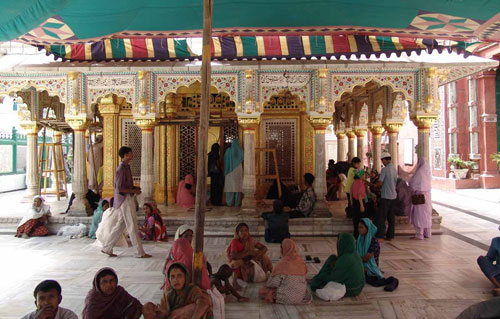|
|
The South
Asian Life & Times - SALT |
|
|||
|
Contents Feature Heritage People
Book Reviews Kaavad
Traditions of Rajasthan
- exploring
|
|
||||
|
Nizamuddin dargah has a universal appeal. It is one of those rare places
where Muslims, Hindus, Christians – people of all faiths - pray alongside.
The 14th
century Sufi saint Hazrat Nizamuddin Auliya, who lived and died here, was
one of the most prominent figures in Sufi Islam. His message of humility,
mercy, and religious tolerance held a mass appeal. Followers and devotees
came from all classes. He not only promoted Hindi as lingua franca for
India, but “equally emphasised the importance of better understanding and
appreciation of various religious traditions, customs and history.” He
advised his ardent disciple/devotee the poet Amir Khusro to write in Hindi
“so as to popularise the language among Muslims. A common language helps
remove the feeling of estrangement and can bring the communities closer."
The area where the dargah and basti are located was once known as Ghiyaspur.
It was after the saint’s death that it was renamed Nizamuddin in his honour.
The dargah is the place of his burial, the place where his physical remains
lay. It has grown into a significant pilgrimage destination. Devotees and
followers from all faiths and religions travel across the Indian
subcontinent and the world to his shrine, particularly at the time of his
‘urs’ or death anniversary.
While urs is the death anniversary, the birth anniversary of Hazrat
Nizamuddin Auliya is known as Ghusal Sharif.
It was recently celebrated on 16 December 2014. The shrine was bedecked with
flowers for the occasion. “While the espresso coffee machine was placed
beside an unknown stone grave, a sophisticated audio system for the
night-long qawwali session was set up inside the beautiful open-air tomb of
Princess Jahanara. The highlight was Ustad Nishat Khan’s sitar recital.” -
Mayank Austen Soofi
“Chahal
Roza
is the biography of Hazrat Nizamuddin Auliya (1238-1325). It was penned by
Raja Hardev, a scion of the Maratha royal family of Devgarh and an ardent
devotee of the saint. The book not only gives the life account of Hazrat
Nizamuddin but highlights his instructions and teachings to strengthen the
bonds of harmony and unity among Indians.” – Arif M Khan
|
|||||
|
Copyright © 2000 - 2015 [the-south-asian.com]. Intellectual Property. All rights reserved. |
|||||
